Sites: news | india | latam | brasil | indonesia
Feeds: news | india | latam | brasil | indonesia
topic: Ecosystem Services Payments
Social media activity version | Lean version
To reverse deforestation and protect biodiversity, build a bioeconomy in the Amazon (commentary)
- Slowing and reversing deforestation and land degradation in the Amazon requires not only conservation efforts but also increasing the economic value of standing primary forests through a bioeconomy approach, argues Robert Muggah, co-founder of Instituto Igarapé.
- A bioeconomy involves regenerative agriculture, sustainable energy, and other activities that leverage the forest’s natural assets while ensuring economic benefits for local communities. However, the expansion of the bioeconomy faces challenges, including resistance from extractive sectors, investment risks, and the need for infrastructure, research, and support for local enterprises.
- Despite these hurdles, advancing the bioeconomy is essential for sustainable development and decarbonization in the Amazon and crucial for the world, says Muggah.
- This post is a commentary. The views expressed are those of the authors, not necessarily Mongabay.
Does the Global Biodiversity Framework give due consideration to market mechanisms? (commentary)
- The recently approved “Kunming-Montreal Global Biodiversity Framework” is meant to guide countries’ efforts to conserve biodiversity.
- It provides specific guidance on how its targets may be achieved, and in that sense, takes a regulatory approach.
- The authors of a new op-ed argue that market mechanisms must also be highly considered, given the ability of things like sustainably certified products to fetch higher prices while generating benefits for biodiversity, “payments for ecosystem services” programs that generate billions of dollars in annual transactions, and more.
- This post is a commentary. The views expressed are those of the authors, not necessarily of Mongabay.
NGOs alert U.N. to furtive 2-million-hectare carbon deal in Malaysian Borneo
- Civil society organizations have complained to the United Nations about an opaque “natural capital” agreement in the Malaysian state of Sabah on the island of Borneo.
- The agreement, signed behind closed doors in October 2021, involved representatives from the state government and Hoch Standard Pte. Ltd., a Singaporean firm. But it did not involve substantive input from the state’s numerous Indigenous communities, many of whom live in or near forests.
- The terms ostensibly give Hoch Standard the right to monetize carbon and other natural capital from Sabah’s forests for 100 years.
- Along with the recent letter to the U.N., the state’s attorney general has questioned whether the agreement is enforceable without changes to key provisions. An Indigenous leader is also suing the state over the agreement, and Hoch Standard may be investigated by the Singaporean government after rival political party leaders in Sabah reported the company to Singapore’s ambassador in Malaysia.
Indigenous-led report warns against ‘simplistic take on conservation’
- To deal with climate change and biodiversity loss effectively and equitably, conservation needs to adopt a human rights-based approach, according to a new report co-authored by Indigenous and community organizations across Asia.
- Unlike spatial conservation targets such as “30 by 30,” a rights-based approach would recognize the ways in which Indigenous people lead local conservation efforts, and prioritize their tenure rights in measuring conservation success.
- Without tenure rights, strict spatial conservation targets could lead to human rights abuses, widespread evictions of Indigenous communities across Asia, and high resettlement costs, the report warned.
- Also without tenure rights, the inflow of money into nature-based solutions such as carbon offsets and REDD+ projects could also result in massive land grabs instead of benefiting local communities.
Malaysian officials dampen prospects for giant, secret carbon deal in Sabah
- The attorney general of the Malaysian state of Sabah has said that a contentious deal for the right to sell credits for carbon and other natural capital will not come into force unless certain provisions are met.
- Mongabay first reported that the 100-year agreement, which involves the protection of some 2 million hectares (4.9 million acres) from activities such as logging, was signed in October 2021 between the state and a Singapore-based firm called Hoch Standard.
- Several leaders in the state, including the attorney general, have called for more due diligence on the companies involved in the transaction.
- Civil society representatives say that a technical review of the agreement is necessary to vet claims about its financial value to the state and its feasibility.
Indigenous leader sues over Borneo natural capital deal
- An Indigenous leader in Sabah is suing the Malaysian state on the island of Borneo over an agreement signing away the rights to monetize the natural capital coming from the state’s forests to a foreign company.
- Civil society and Indigenous organizations say local communities were not consulted or asked to provide input prior to the agreement’s signing on Oct. 28.
- Further questions have arisen about whether the company, Hoch Standard, that secured the rights under the agreement has the required experience or expertise necessary to implement the terms of the agreement.
Is colonial history repeating itself with Sabah forest carbon deal? (commentary)
- To the surprise of Indigenous and local communities, a huge forest carbon conservation agreement was recently signed in the Malaysian state of Sabah on the island of Borneo.
- Granting rights to foreign entities on more than two million hectares of the state’s tropical forests for the next 100-200 years, civil society groups have called for more transparency.
- “Is history repeating itself? Are we not yet free or healed from our colonial and wartime histories?” wonders a Sabahan civil society leader who authored this opinion piece calling for more information, more time, and a say.
- This post is a commentary. The views expressed are those of the author, not necessarily of Mongabay.
Details emerge around closed-door carbon deal in Malaysian Borneo
- Leaders in Sabah have begun to reveal information about a nature conservation agreement signed in the Malaysian state of Sabah on the island of Borneo for the rights to carbon and other natural capital.
- The deal allegedly covers rights to more than 2 million hectares (4.9 million acres) of the state’s tropical forests for the next 100-200 years.
- Indigenous and civil society groups have called for more transparency.
- In response to the public reaction to news of the agreement, its primary proponent, Deputy Chief Minister Jeffrey Kitingan, held a public meeting but has declined to make the agreement public yet.
Bornean communities locked into 2-million-hectare carbon deal they don’t know about
- Leaders in Sabah, a Malaysian state on the island of Borneo, signed a nature conservation agreement on Oct. 28 with a group of foreign companies — apparently without the meaningful participation of Indigenous communities.
- The agreement, with the consultancy Tierra Australia and a private equity-backed funder from Singapore, calls for the marketing of carbon and other ecosystem services to companies looking, for example, to buy credits to offset their emissions.
- The deal involves more than 2 million hectares (4.9 million acres) of forest, which would be restored and protected from mining, logging and industrial agriculture for the next 100-200 years.
- But land rights experts have raised concerns about the lack of consultation with communities living in and around these forests in the negotiations to this point.
Indigenous Land in the Brazilian Amazon is a brake on deforestation and may start generating carbon credits
- A study says that Brazil’s Puyanawa Indigenous people will prevent around 6,400 tons of carbon dioxide emissions per year by 2025, equivalent to about $38,000 annually.
- Practices such as putting agricultural activities in previously degraded areas, forest restoration and agroforestry have prevented deforestation in their western Amazon reserve, which has dropped by half in recent years.
- The latest survey from Brazilian mapping project Mapbiomas shows that the country’s forests and native vegetation are best preserved in Indigenous territories.
As COP26 looms and tropical deforestation soars, REDD+ debate roars on
- The United Nations REDD+ program (reduced emissions from deforestation and forest degradation) has been operating for more than 13 years as a multipurpose initiative, intended to curb deforestation in tropical nations, sequester forest carbon, combat climate change, protect biodiversity, and aid poor rural communities.
- The REDD+ mechanism is largely paid for by wealthy industrialized countries contributing funds to less developed tropical nations, including those in the Amazon, Congo Basin and Indonesia.
- Some 600 REDD+ projects have been initiated to date (with some 400 still active), mostly implemented by socioenvironmental NGOs or for-profit project developers, and financed by more than $10 billion in donor funds in more than 65 countries. But evidence of avoided deforestation and reduced carbon emissions is controversial.
- With the COP26 Glasgow climate summit looming in November, Mongabay invited experts to weigh in on the global initiative’s successes and failings, with some supporting expansion of REDD+ via revised program rules and funding, while others support major reforms, or even the initiative’s replacement.
Government inaction prompts voluntary REDD+ carbon credit boom in Brazil
- With the Bolsonaro government largely indifferent to participating in a carbon credit market, and amid intensifying pressure from clients and investors, a voluntary carbon credit market is booming in Brazil. The country, however, still doesn’t have any regulation about how and by whom credits can be issued.
- REDD+ projects that issue carbon credits for reforesting or avoiding deforestation have caught the attention of financial market players. Amid the new carbon credit trading firms, such as financial technology company Moss, and other initiatives, Brazilian projects offer both examples of success and failure in forest preservation.
- REDD+ supporters argue Brazil’s voluntary carbon credit market is allowing small-scale farmers and Indigenous and traditional people to get in the game, benefiting them financially, and helping conserve forests and protect the Earth’s climate.
- But critics say it’s difficult to ensure that forest conservation promises made today can be kept in the future, especially in a nation notorious for illegal deforestation and record forest fires. Also, protecting one area can simply drive the deforestation to another area.
Ambitious return to carbon markets to conserve Africa’s forests
- Growth of voluntary carbon market and new investor interest in natural climate solutions in Africa prompts The Nature Conservancy to launch effort to help local enterprises raise $300 million for forest conservation.
- The Africa Forest Carbon Catalyst will initially identify existing projects with potential to protect 100,000 hectares of natural forest or sequester three million tonnes of CO2 over 10 years.
- Clarifying and securing the rights, involvement, and benefits for local communities is a key challenge.
How the pandemic impacted rainforests in 2020: a year in review
- 2020 was supposed to be a make-or-break year for tropical forests. It was the year when global leaders were scheduled to come together to assess the past decade’s progress and set the climate and biodiversity agendas for the next decade. These included emissions reductions targets, government procurement policies and corporate zero-deforestation commitments, and goals to set aside protected areas and restore degraded lands.
- COVID-19 upended everything: Nowhere — not even tropical rainforests — escaped the effects of the global pandemic. Conservation was particularly hard in tropical countries.
- 2019’s worst trends for forests mostly continued through the pandemic including widespread forest fires, rising commodity prices, increasing repression and violence against environmental defenders, and new laws and policies in Brazil and Indonesia that undermine forest conservation.
- We don’t yet have numbers on the degree to which the pandemic affected deforestation, because it generally takes several months to process that data. That being said, there are reasons to suspect that 2020’s forest loss will again be substantial.
REDD+ carbon and deforestation cuts in Amazon overestimated: Study
- A new study analyzed 12 REDD+ (Reduced Emissions from Deforestation and forest Degradation) voluntary projects conducted in the Brazilian Amazon.
- Researchers found that the projects’ claimed reductions in forest loss and carbon emissions were seriously overstated due to poorly set deforestation rate baselines that didn’t properly account for other successful forest loss reductions that were achieved separately by the Brazilian government.
- To correct this problem in future, the researchers expressed the “need to better align project- and national-level carbon accounting,” while at the same time striking a balance between “controlling conservation investment risk and ensuring the environmental integrity of carbon emission offsets.”
- Suggestions for achieving more reliable carbon accounting include: only taking into account the most recent years of deforestation, relying on more complex models that look at the price of agricultural commodities, and comparing deforestation to similar areas not involved in REDD+ projects.
The Amazon savanna? Rainforest teeters on the brink as climate heats up
- A new study has found that 40% of the Amazon is at risk of turning into savanna due to decreases in rainfall.
- The paper’s authors used satellite data, climate simulations and hydrological models to better understand the dynamics of rainfall across the tropics and their impacts on the stability of tropical forest ecosystems.
- The team’s simulations suggest that sustained high greenhouse gas emissions through the end of the century could shrink the minimum size of the Amazon by 66%.
Podcast: From parks to payments, which conservation strategies work best?
- This is the 100th episode of the Mongabay Newscast! We revisit Mongabay’s groundbreaking Conservation Effectiveness reporting project in order to see what developments there have been since we did the initial reporting three years ago.
- Joining us today are Mongabay founder and CEO Rhett Butler, who tells us about the impetus for the series of reports that would become Conservation Effectiveness, what the main findings were from the project, and the new developments over the past three years that might help fill the gaps in our understanding of conservation impacts.
- We also speak with Sven Wunder, a principal scientist at the European Forest Institute in Barcelona, Spain as well as a senior associate at the Center for International Forestry Research, or CIFOR. Wunder actually spoke with me back in 2017 for the piece I wrote about PES as part of the Conservation Effectiveness series, and we’ve spoken again for this episode of the podcast so he can fill us in on the latest research into the impact of a variety of conservation strategies.
We need a green life support plan (commentary)
- Tourism — much of it nature-based – comprises 2% of sub-Saharan African nations’ GDP, which can rise to up to 38% for some countries. It is also critical to sovereign credit analysis, giving countries access to capital markets, external financing and funds to support government programs, including nature-based tourism. But with the collapse of international tourism in response to COVID-19, sub-Saharan African countries are facing credit rating downgrade risks, putting conservation funding at risk.
- Without income from nature-based tourism, many small- and medium-size enterprises in the nature-based tourism sector risk closure, and wildlife conservation will be seriously compromised as landowners and locals could be incentivized to convert conserved land into agriculture production and partake in illegal activities such as overfishing, with significant negative results for countries’ nature-based assets.
- With the long-term sustainability of these nature-dependent economies threatened, the authors argue for standardized, methodical and systemic funding for the conservation, protection and restoration of the natural capital.
- This post is a commentary. The views expressed are those of the authors, not necessarily Mongabay.
In the battle to save forests, a make-or-break moment for REDD+
- In Part Two of this series delving into REDD+, Mongabay looks at whether it can still accomplish the stated mission, what it would take to make that happen, and why, despite more than a decade of disappointment and controversy, REDD+ true believers still hold out hope.
- REDD+ advocates have now hung their hopes on a private sector suddenly hungry to buy carbon credits to offset greenhouse gas emissions. Private sector demand for carbon credits, they hope, will increase the volume and push up the price of REDD+ carbon credits, both of which are necessary to drive much-needed financing into forest conservation.
- In early 2020, this hope appeared closer than ever to becoming a reality — then the coronavirus pandemic hit, causing private sector demand for carbon credits to plummet. Some of this decrease could turn out to be short term, but demand from at least one key sector, the airline industry, could take years to rebound.
- Another challenge facing REDD+ is a disagreement over whether individual project developers should be allowed to sell carbon credits directly to buyers, or if that should be left to the countries or states where the projects are located.
The U.N.’s grand plan to save forests hasn’t worked, but some still believe it can
- Part one explores REDD+’s evolution up to the present: how a lofty plan meant to generate large-scale financing for global forest conservation and climate mitigation became a patchwork of individual projects and programs that have failed to achieve the central goal of curbing deforestation.
- Recent developments could represent something of a turning point for REDD+, including the first large-scale, “results-based” funding — the conditional financial incentives seen as key to REDD+’s success — from the U.N.-REDD Programme and the World Bank, and a surge in private-sector dollars for forest conservation and reforestation projects that could mark the beginning of a significant new source of cash.
- However, challenges remain to delivering REDD+ at its intended scale, not least of which is the economic fallout of the coronavirus pandemic, which could potentially trip up progress just as REDD+ looked poised to gain some real ground.
Market-based solutions cannot solely fund community-level conservation (commentary)
- In the last two decades, conservation and the market economy merged into what is called “neoliberal conservation,” where economic growth and the protection of nature are thought to be essentially compatible.
- However, conservation in places like North Sumatra will be last on the agenda when markets tumble and the economic system that people are now addicted to – in even the most remote places – collapses.
- Schemes like ecotourism and payment for ecosystem services should be paired with programs like sustainable local agriculture to prevent the re-emergence of poaching and illegal logging, and to ensure that conservation-oriented behaviors persist when markets fail.
- This article is a commentary and does not necessarily reflect the views of Mongabay.
Tourism has crashed: Are carbon credits the future for funding conservation in Africa?
- Protected areas in Africa are grossly underfunded, leaving them exposed to degradation.
- Tanzania’s Yaeda Valley REDD+ project demonstrates how carbon credits can provide communities and governments economic incentives to protect valuable habitat.
- Real potential to replicate the model elsewhere — and ensure conserving carbon stocks leads to conserving wildlife — remains uncertain.
Investing in Amazon Rainforest Conservation: A Foreigner’s Perspective (commentary)
- Deforestation in the Brazilian Amazon has been trending upward since 2012, with a sharp acceleration since January 2019.
- Jonah Wittkamper, President of the Global Governance Philanthropy Network and co-founder of NEXUS, reviews the current situation and provides a perspective on how it might be possible to slow or reverse deforestation by investing in Amazon rainforest conservation.
- Wittkamper wrote this report to help guide investors and philanthropists on their learning journeys on the issue.
- This post is a commentary and does not necessarily reflect the views of Mongabay.
Biodiversity ‘not just an environmental issue’: Q&A with IPBES ex-chair Robert Watson
- The World Bank and IMF meetings from Oct. 14-20 will include discussions on protecting biodiversity and the importance of investing in nature.
- A recent U.N. report found that more than 1 million species of plants and animals face extinction.
- In a conversation with Mongabay, Robert Watson, who chaired the Intergovernmental Science-Policy Platform on Biodiversity and Ecosystem Services that produced the report, discusses the economic value of biodiversity.
Dam in Ethiopia has wiped out indigenous livelihoods, report finds
- A dam in southern Ethiopia built to supply electricity to cities and control the flow of water for irrigating industrial agriculture has led to the displacement and loss of livelihoods of indigenous groups, the Oakland Institute has found.
- On June 10, the policy think tank published a report of its research, demonstrating that the effects of the Gibe III dam on the Lower Omo River continue to ripple through communities, forcing them onto sedentary farms and leading to hunger, conflict and human rights abuses.
- The Oakland Institute applauds the stated desire of the new government, which came to power in April 2018, to look out for indigenous rights.
- But the report’s authors caution that continued development aimed at increasing economic productivity and attracting international investors could further marginalize indigenous communities in Ethiopia.
Altered forests threaten sustainability of subsistence hunting
- In a commentary, two conservation scientists say that changes to the forests of Central and South America may mean that subsistence hunting there is no longer sustainable.
- Habitat loss and commercial hunting have put increasing pressure on species, leading to the loss of both biodiversity and a critical source of protein for these communities.
- The authors suggest that allowing the hunting of only certain species, strengthening parks and reserves, and helping communities find alternative livelihoods and sources of food could help address the problem, though they acknowledge the difficult nature of these solutions.
’Unprecedented’ loss of biodiversity threatens humanity, report finds
- The U.N.’s Intergovernmental Science-Policy Platform on Biodiversity and Ecosystem Services released a summary of far-reaching research on the threats to biodiversity on May 6.
- The findings are dire, indicating that around 1 million species of plants and animals face extinction.
- The full 1,500-page report, to be released later this year, raises concerns about the impacts of collapsing biodiversity on human well-being.
Community buy-in stamps out elephant poaching in Zambian park
- No elephants were poached in Zambia’s North Luangwa National Park in 2018, and the surrounding area had a 50 percent decrease in poached carcasses found.
- The North Luangwa Conservation Programme, a partnership between the Frankfurt Zoological Society and the country’s Department of Parks and Wildlife, has been around since the late 1980s and has focused its efforts on community involvement in stopping poachers from going after elephants, rhinos and other wildlife in the park.
- Staff of the program say the participation of the communities living near the park’s borders is critical to protecting the elephants of North Luangwa.
- The broader Luangwa ecosystem is home to more than 63 percent of Zambia’s elephants.
Deforestation diminishes access to clean water, study finds
- A recent study compared deforestation data and information on household access to clean water in Malawi.
- The scientists found that the country lost 14 percent of its forest between 2000 and 2010, which had the same effect on access to safe drinking water as a 9 percent decrease in rainfall.
- With higher rainfall variability expected in today’s changing climate, the authors suggest that a larger area of forest in countries like Malawi could be a buffer against the impacts of climate change.
Study concludes that nature benefits when more women make land management decisions
- A study led by researchers at the University of Colorado Boulder (CU Boulder) and published in the journal Nature Climate Change last month explored whether or not gender quotas for local governing bodies could help reduce deforestation while addressing local inequalities at the same time.
- For the study, researchers traveled to 31 villages near collectively managed forests in three developing countries — Indonesia, Peru, and Tanzania — and asked 440 forest users in those communities to play a tabletop simulation game in which they had to make decisions about how many trees to harvest from a shared forest. The participants were divided into groups of eight, and half the groups were required to have women as 50 percent of their members. The other half of the groups had no gender quotas.
- The authors write in the study that their results “show that gender quotas make interventions more effective and lead to more equal sharing of intervention benefits.”
The biggest rainforest news stories in 2018
- This is our annual rainforests year in review post.
- Overall, 2018 was not a good year for the planet’s tropical rainforests.
- Rainforest conservation suffered many setbacks, especially in Brazil, the Congo Basin, and Madagascar.
- Colombia was one of the few bright spots for rainforests in 2018.
Tracking the shift of tropical forests from carbon sink to source
- Improved maps of carbon stocks, along with a better understanding of how tropical forests respond to climate change, are necessary to meet the challenge of keeping the global temperature below a 2-degree-Celsius (3.6-degree-Fahrenheit) rise, according to scientist Edward Mitchard of the University of Edinburgh.
- Currently, tropical forests take up roughly the same amount of carbon as is released when they’re cleared or degraded.
- But climatic changes, which lead to more droughts and fires resulting in the loss of tropical trees, could shift the balance, making tropical forests a net source of atmospheric carbon.
Forest communities pay the price for conservation in Madagascar
- In a two-year investigation of a REDD+ pilot project, a team of researchers spoke with more than 450 households affected by the establishment of a large protected area called the Ankeniheny-Zahamena Corridor, a 3,820-square-kilometer (1,475-square-mile) tract of rainforest in eastern Madagascar.
- The REDD+ project, supported by Conservation International and the World Bank, was aimed at supporting communities by providing support for alternative livelihoods to those communities near the Ankeniheny-Zahamena Corridor protected area.
- They found that the REDD+ project’s preliminary studies identified less than half of those negatively affected by the Corridor’s designation.
- The team also discovered that the value of the one-off compensation, in the form of support to pursue other livelihoods, fell far short of the opportunity costs that the communities are likely to face as a result of losing access to the forest in the coming decades.
Payments for ecosystem services can boost social capital in addition to forest management: Study
- New research finds that a national payments for ecosystem services (PES) program in Mexico not only benefits the environment but supports social relationships in local communities, as well.
- Two US-based economists, Oregon State University’s Jennifer Alix-Garcia and Amherst College’s Katharine Sims, led a team that looked at how participation in PES programs impacted social relationships in Mexico’s agrarian communities — local governance structures that make joint decisions about land management and are formally recognized by the Mexican government. Approximately half of forested land in Mexico is governed under these communal structures.
- As detailed in PNAS, the researchers found that participation in Mexico’s PES program improved “community social capital” — defined as “the institutions, relationships, attitudes, and values that govern human interactions” — by 8 to 9 percent.
Researchers propose framework for designing PES programs that better deliver socioeconomic benefits
- The authors of a study recently published in the journal Science Advances developed a framework for examining the numerous ways Payments for Ecosystem Services (PES) programs affect socioeconomic outcomes by taking into account how PES programs are linked to various livelihood activities.
- The researchers applied their framework to two PES programs in China’s Wolong Nature Reserve, both designed to reduce the degradation of panda habitat due to human activities like agricultural expansion, timber harvesting, and fuelwood collection.
- They found that households in Wolong Nature Reserve would have been better off financially had they not enrolled their land in either of these PES programs and instead continued to grow and sell crops.
- The researchers write that using their framework for understanding all of the underlying effects on local livelihoods, however, it is possible for conservation practitioners to anticipate obstacles and design management strategies for PES programs that improve their socioeconomic performance.
New research examines spread of payments for ecosystem services around the globe
- There are currently more than 550 PES programs active around the world in developed and developing countries alike, and more than $36 billion in annual transactions have been made through these programs, according to a study published last month in the journal Nature Sustainability.
- Researchers found that PES programs designed to protect watersheds have seen the largest volume of global transactions and have spread the farthest worldwide, with $24.7 billion in transactions across 62 countries in 2015.
- Little research has focused on the question of whether or not any benefits of PES are sustained after payments cease, according to another study recently published in Nature Sustainability. But that research suggests that paying rural villagers to cut down fewer trees can not only boost conservation efforts while the payments are being made but even after they’re discontinued.
Report finds projects in DRC ‘REDD+ laboratory’ fall short of development, conservation goals
- The Rights and Resources Initiative (RRI) released a new report that found that 20 REDD+ projects in a province in DRC aren’t set to address forest conservation and economic development — the primary goals of the strategy.
- The Paris Agreement explicitly mentions the role of REDD+ projects, which channel funds from wealthy countries to heavily forested ones, in keeping the global temperature rise below 2 degrees Celsius this century.
- RRI is asking REDD+ donors to pause funding of projects in DRC until coordinators develop a more participatory approach that includes communities and indigenous groups.
Mangrove deforestation may be releasing more CO2 than Poland, study finds
- A new study calculates that, worldwide, mangroves were storing 4.19 billion metric tons of carbon in 2012, representing a 2 percent loss since 2000. It estimates that number had dropped further to 4.16 billion metric tons by 2017.
- In total, the study estimates that this lost carbon translates to as much as 317 million tons of CO2 emissions per year, equivalent to the annual emissions of around 67.5 million passenger vehicles in the U.S. and more than the 2015 emissions of Poland.
- The researchers found Indonesia harbors the lion’s share of the world’s mangroves – around 30 percent – while also experiencing the biggest proportion of its 2000-2012 mangrove carbon loss, with deforestation there accounting for more than 48 percent of the global total. Other parts of Southeast Asia, such as Myanmar, are also undergoing high rates of mangrove deforestation, making the entire region a hotspot of global mangrove carbon loss.
- Previous research estimates that between 30 and 50 percent of the world’s mangroves have been lost over the past 50 years. Deforestation for shrimp, rice and palm oil are among the biggest drivers of mangrove decline.
Carbon pricing could save millions of hectares of tropical forest: new study
- Recently published research in the journal Environmental Research Letters found that setting a price of $20 per metric ton (about $18/short ton) of carbon dioxide could diminish deforestation by nearly 16 percent and the amount of carbon released into the atmosphere by nearly 25 percent.
- The pair of economists calculated that, as things currently stand, the world stands to lose an India-size chunk of tropical forest by 2050.
- In addition to carbon pricing, stricter policies to halt deforestation, such as those that helped Brazil cut its deforestation rate by 80 percent in the early 2000s, could save nearly 1 million square kilometers (386,000 square miles).
Maps tease apart complex relationship between agriculture and deforestation in DRC
- A team from the University of Maryland’s GLAD laboratory has analyzed satellite images of the Democratic Republic of Congo to identify different elements of the “rural complex” — where many of the DRC’s subsistence farmers live.
- Their new maps and visualizations allow scientists and land-use planners to pinpoint areas where the cycle of shifting cultivation is contained, and where it is causing new deforestation.
- The team and many experts believe that enhanced understanding of the rural complex could help establish baselines that further inform multi-pronged approaches to forest conservation and development, such as REDD+.
Carbon dreams: Can REDD+ save a Yosemite-size forest in Madagascar?
- When Makira Natural Park launched in 2005, it seemed to present a solution to one of the most intractable problems in conservation: finding a source of funding that could be counted on year after year.
- The sale of carbon offset credits would fund the park itself as well as development projects aimed at helping nearby communities improve their standard of living and curtail deforestation.
- But more than a decade later, carbon buyers are scarce and much of the funding for community development has been held up. And although deforestation has slowed considerably in and around Makira, it is falling well short of deforestation targets set at the outset of the project.
- This is the seventh story in Mongabay’s multi-part series “Conservation in Madagascar.”
Cash for conservation: Do payments for ecosystem services work?
- What can we say about the effectiveness of payments for ecosystem services (PES) based on the available scientific literature? To find out, we examined 38 studies that represent the best evidence we could find.
- The vast majority of the evidence in those 38 studies was still very weak, however. In other words, most of the studies did not compare areas where PES had been implemented with non-PES control areas or some other kind of countervailing example.
- On average, the more rigorously designed studies showed very modest reductions in deforestation, generally of just a few percentage points. Meanwhile, the majority of the available evidence suggests that payments were often too low to cover the opportunity costs of agricultural development or other profitable activities that the land could have been used for.
- This is part of a special Mongabay series on “Conservation Effectiveness.”
Sudden sale may doom carbon-rich rainforest in Borneo
- Forest Management Unit 5 encompasses more than 101,000 hectares in central Sabah, a Malaysian state on the island of Borneo.
- The area’s steep slopes and rich forests provide habitat for the Bornean orangutan and other endangered species and protect watersheds critical to downstream communities.
- Conservation groups had been working with the government and the concession holder to set up a concept conservation economy on FMU5, but in October, the rights were acquired by Priceworth, a wood product manufacturing company.
Conservation, Divided: in-depth series starts Tuesday
- Conservation, Divided is an in-depth four-part series investigating how the field of conservation has changed over the last 30 years — and the challenges it faces moving into an uncertain future.
- Veteran Mongabay reporter Jeremy Hance completed the series over the course of eight months.
- Conservation, Divided launches next Tuesday, April 26. Stories will run weekly through May 17.
Researchers say you get what you pay for when it comes to payments for ecosystem services
- Researchers at Michigan State University wanted to determine whether or not programs that compensate local communities monetarily for their active participation in conservation efforts really works.
- Their study focuses on China’s National Forest Conservation Program, which aims to restore forests and habitat for the endangered giant panda, an important “umbrella species.”
- The MSU researchers say their results show the power of engaging forest communities in payments for ecosystem services schemes.
The state of the market for ecosystem services
- Payments for ecosystem services programs involve evaluating the monetary value to society of natural “services,” such as clean water, biodiversity, or reduced atmospheric carbon, and then compensating people who manage land that provides these services.
- The concept has been around for about a century, but took off around the globe about fifteen years ago.
- Both the philosophy behind attaching an economic value to a natural process and its practical application have proved to be controversial, complicated, and difficult.
Carbon storage for sale: USDA grants promote markets for ‘ecosystem services’
- In September, the USDA’s Natural Resources Conservation Service announced its 2015 round of Conservation Innovation Grants. The agency awarded 45 grants totaling about $20 million for projects to improve soil health and to develop environmental markets.
- The environmental markets projects are part of a relatively new approach to conservation known as “payment for ecosystem services.” The idea is to be able to quantify certain seemingly intangible environmental functions, like carbon sequestration, and make it easier and more attractive for investors to buy and sell them in a bid to put more money into conserving natural resources.
- The payment for ecosystem services approach has gained many proponents since it was popularized in 2005, but also detractors.
Norway pays Brazil $1B to fulfill pledge for curbing deforestation
- Norway ponies up $1B to fulfill pledge to Brazil for success in reducing deforestation.
- Forest loss in the Brazilian Amazon in 2014 was 75% below the 1996-2005 baseline.
- But there are signs deforestation may be rising again.
REDD+ carbon market stabilizes, but risk of supply glut looms
 The state of the REDD+ carbon market in 2012 Logging, conversion to plantations and agriculture, and other drivers of deforestation account for roughly ten percent of anthropogenic greenhouse gas emissions The market for carbon credits generated under projects that reduce emissions from deforestation and forest degradation (REDD) showed signs of stabilizing in 2012 after a […]
The state of the REDD+ carbon market in 2012 Logging, conversion to plantations and agriculture, and other drivers of deforestation account for roughly ten percent of anthropogenic greenhouse gas emissions The market for carbon credits generated under projects that reduce emissions from deforestation and forest degradation (REDD) showed signs of stabilizing in 2012 after a […]
Developer of Indonesia’s first REDD+ project confirms status of forest conservation initiative
 Infinite Earth, the developer behind Indonesia’s first approved REDD+ project, has refuted an NGO’s claims that the project has been only partially approved by the Indonesian government. In a statement sent to Mongabay.com, Infinite Earth confirmed that its Rimba Raya project in Central Kalimantan has an ecosystem restoration permit for more than 36,000 hectares of […]
Infinite Earth, the developer behind Indonesia’s first approved REDD+ project, has refuted an NGO’s claims that the project has been only partially approved by the Indonesian government. In a statement sent to Mongabay.com, Infinite Earth confirmed that its Rimba Raya project in Central Kalimantan has an ecosystem restoration permit for more than 36,000 hectares of […]
Market for REDD+ carbon credits declines 8% in 2012
 The market for carbon credits generated from projects that reduce deforestation and forest degradation — a climate change mitigation approach known as REDD+ — dipped eight percent in 2012 according to an annual assessment of the global voluntary carbon market. The report, published by Ecosystem Marketplace and Bloomberg New Energy Finance and slated to be […]
The market for carbon credits generated from projects that reduce deforestation and forest degradation — a climate change mitigation approach known as REDD+ — dipped eight percent in 2012 according to an annual assessment of the global voluntary carbon market. The report, published by Ecosystem Marketplace and Bloomberg New Energy Finance and slated to be […]
Progress in incentive-based protection of forests and other watersheds
 There are two ways to look at Charting New Waters: State of Watershed Payments 2012 – the latest report released by Forest Trends on incentive-based water protection. One is that investments in watershed protection are fast approaching a tipping point – rising 25% from the previous year and with 25% of all recorded investments occurring […]
There are two ways to look at Charting New Waters: State of Watershed Payments 2012 – the latest report released by Forest Trends on incentive-based water protection. One is that investments in watershed protection are fast approaching a tipping point – rising 25% from the previous year and with 25% of all recorded investments occurring […]
The need to jump-start REDD to save forests
 Mongabay.com is partnering with the Skoll Foundation ahead of the Skoll World Forum on Social Entrepreneurship to bring a series of perspectives that aim to answer the question: how do we feed the world and still address the drivers of deforestation? HOW DO WE FEED THE WORLD AND STILL ADDRESS THE DRIVERS OF DEFORESTATION? Soy, […]
Mongabay.com is partnering with the Skoll Foundation ahead of the Skoll World Forum on Social Entrepreneurship to bring a series of perspectives that aim to answer the question: how do we feed the world and still address the drivers of deforestation? HOW DO WE FEED THE WORLD AND STILL ADDRESS THE DRIVERS OF DEFORESTATION? Soy, […]
Over $8 billion invested in watersheds in 2011
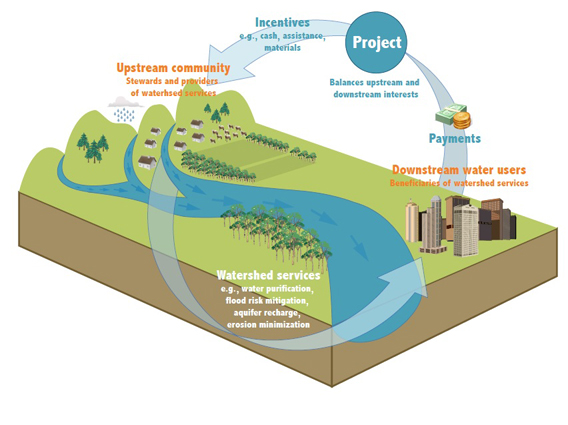 How a sample payment for ecosystem services project works. Click to enlarge. Unlike cars, hamburgers, and computers, clean drinking water is a requirement for human survival. In a bid to safeguard this essential resource, more and more nations are moving toward protecting ecosystems, such as forests, wetlands, and streams. In fact, according to a new […]
How a sample payment for ecosystem services project works. Click to enlarge. Unlike cars, hamburgers, and computers, clean drinking water is a requirement for human survival. In a bid to safeguard this essential resource, more and more nations are moving toward protecting ecosystems, such as forests, wetlands, and streams. In fact, according to a new […]
South Sudan’s choice: resource curse or wild wonder?
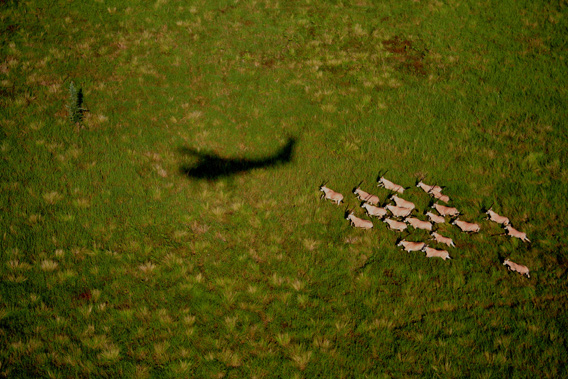 This commentary was originally published in February, but given that South Sudan has just celebrated independence over the weekend, we thought it apt to re-publish. Oryx and WCS Cessna shadow, Boma National Park. Photo by Paul Elkan and J. Michael Fay. ©2007 National Geographic/ Wildlife Conservation Society. After the people of South Sudan have voted […]
This commentary was originally published in February, but given that South Sudan has just celebrated independence over the weekend, we thought it apt to re-publish. Oryx and WCS Cessna shadow, Boma National Park. Photo by Paul Elkan and J. Michael Fay. ©2007 National Geographic/ Wildlife Conservation Society. After the people of South Sudan have voted […]
Despite setbacks, voluntary carbon markets booming
The voluntary carbon market posted a 34 percent gain in 2010, trading a record 131 million tons of carbon dioxide equivalent (MtC02e). While the US accounted for the majority of trading activity, worth $424 million in total, market growth was strongest in developing countries. The news comes from Back to the Future: State and Trends […]
Environmental sustainability—the new economic bottom line
That’s the message in Accounting for Sustainability: Practical Insights. The book represents the compilation of a five-year project—nicknamed “A4S”—sponsored by Prince Charles, Prince of Wales, that examined the feasibility of factoring industries’ impact on the environment into their economic spread sheets. Using case studies and interviews with leaders at major accounting firms, Accounting For Sustainability […]
As South Sudan eyes independence, will it choose choose to protect its wildlife?
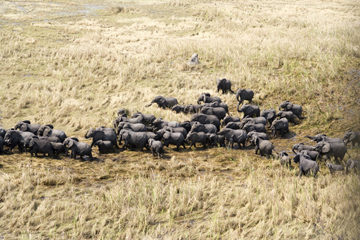 After the people of South Sudan have voted overwhelmingly for independence, the work of building a nation begins. Set to become the world’s newest country on July 9th of this year, one of many tasks facing the nation’s nascent leaders is the conservation of its stunning wildlife. In 2007, following two decades of brutal civil […]
After the people of South Sudan have voted overwhelmingly for independence, the work of building a nation begins. Set to become the world’s newest country on July 9th of this year, one of many tasks facing the nation’s nascent leaders is the conservation of its stunning wildlife. In 2007, following two decades of brutal civil […]
Obama’s State of the Union salmon joke highlights complexity of coastal ecosystem services
U.S. President Barack Obama told his now-famous salmon joke on Tuesday to illustrate the silliness of unnecessarily complex regulation, but the joke says more about the complexity of coastal ecosystems – and the challenge of keeping them intact in the face of growing development – than it does about regulatory dysfunction. It’s a challenge that […]
Jackpot: how international community could raise $141 billion for biodiversity
 Leaders from around the world meeting in Nagoya, Japan for the Convention on Biological Diversity (CBD) to discuss solutions to stem the current mass extinction crisis may be in need of a little book: The Little Biodiversity Finance Book. While a recent report by The Economics of Ecosystems and Biodiversity (TEEB) found that degradation of […]
Leaders from around the world meeting in Nagoya, Japan for the Convention on Biological Diversity (CBD) to discuss solutions to stem the current mass extinction crisis may be in need of a little book: The Little Biodiversity Finance Book. While a recent report by The Economics of Ecosystems and Biodiversity (TEEB) found that degradation of […]
Conserving nature with economics
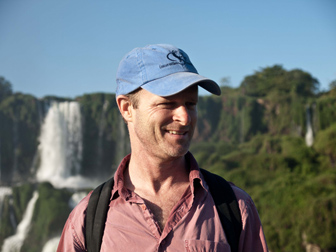 While many factors come into consideration when the fate of forests are being determined, economics often play a key role in land use decisions. When the perceived value of forest land is higher as cattle pasture, cropland, or plantation, then trees fall. But what happens when economic assumptions underlying these decisions are wrong? Forests, including […]
While many factors come into consideration when the fate of forests are being determined, economics often play a key role in land use decisions. When the perceived value of forest land is higher as cattle pasture, cropland, or plantation, then trees fall. But what happens when economic assumptions underlying these decisions are wrong? Forests, including […]
$28 billion pledged by rich nations to fight climate change
 $27.9 billion in “fast-start” funding has so far been pledged by industrialized countries to help developing countries mitigate and adapt to climate change, according to a new climate finance tracking tool released by the World Resources Institute (WRI). The tool aims to create transparency around climate change funds to ensure that rich countries follow through […]
$27.9 billion in “fast-start” funding has so far been pledged by industrialized countries to help developing countries mitigate and adapt to climate change, according to a new climate finance tracking tool released by the World Resources Institute (WRI). The tool aims to create transparency around climate change funds to ensure that rich countries follow through […]
Indonesia gets first $30M from Norway under $1B forest deal
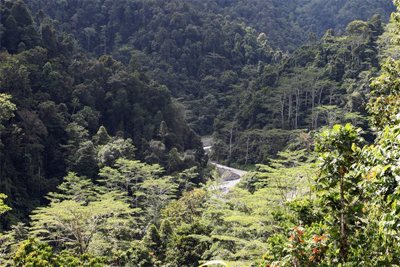 Norway has agreed to transfer an initial $30 million to Indonesia under its $1 billion REDD+ (reducing emissions from deforestation and forest degradation) partnership with the Southeast Asian country. The fund will go towards Phase I of the partnership, which include “the establishment of an Indonesian REDD+ agency, development of a comprehensive national REDD+ strategy, […]
Norway has agreed to transfer an initial $30 million to Indonesia under its $1 billion REDD+ (reducing emissions from deforestation and forest degradation) partnership with the Southeast Asian country. The fund will go towards Phase I of the partnership, which include “the establishment of an Indonesian REDD+ agency, development of a comprehensive national REDD+ strategy, […]
Rencana Indonesia untuk selamatkan hutan hujannya
 Wawancara dengan Agus Purnomo dan Yani Saloh, Asisten Khusus Presiden Republik Indonesia untuk Perubahan Iklim. Akhir tahun lalu, Indonesia membuat berita di dunia dengan janji yang berani untuk mengurangi penggundulan hutan, yang menghabiskan hampir 28 juta hektar (108 mil persegi) hutan antara tahun 1990 dan 2005 dan merupakan sumber sekitar 80 persen dari emisi gas […]
Wawancara dengan Agus Purnomo dan Yani Saloh, Asisten Khusus Presiden Republik Indonesia untuk Perubahan Iklim. Akhir tahun lalu, Indonesia membuat berita di dunia dengan janji yang berani untuk mengurangi penggundulan hutan, yang menghabiskan hampir 28 juta hektar (108 mil persegi) hutan antara tahun 1990 dan 2005 dan merupakan sumber sekitar 80 persen dari emisi gas […]
Indonesia’s plan to save its rainforests
 An interview with Agus Purnomo and Yani Saloh, Special Assistants to the President of the Republic of Indonesia for Climate Change. Late last year Indonesia made global headlines with a bold pledge to reduce deforestation, which claimed nearly 28 million hectares (108,000 square miles) of forest between 1990 and 2005 and is the source of […]
An interview with Agus Purnomo and Yani Saloh, Special Assistants to the President of the Republic of Indonesia for Climate Change. Late last year Indonesia made global headlines with a bold pledge to reduce deforestation, which claimed nearly 28 million hectares (108,000 square miles) of forest between 1990 and 2005 and is the source of […]
Congo basin rainforest countries
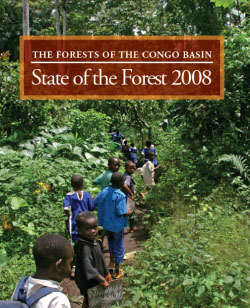 REDD, responsible logging could help preserve Congo forests, reduce poverty, says report Payments for ecosystem services and sustainable forest management may be key components in maintaining Central Africa’s rainforests as healthy and productive ecosystems, finds a comprehensive assessment of the region’s forests. The review, entitled State of the Forest 2008, was released Thursday at an […]
REDD, responsible logging could help preserve Congo forests, reduce poverty, says report Payments for ecosystem services and sustainable forest management may be key components in maintaining Central Africa’s rainforests as healthy and productive ecosystems, finds a comprehensive assessment of the region’s forests. The review, entitled State of the Forest 2008, was released Thursday at an […]
Forest carbon conservation projects top $100 million
New report documents billions of dollars in losses from Indonesia’s reforestation fund between 1989 and 2009. The market for carbon credits generated through forest conservation topped $100 million from 2007 through the first half of 2009, despite a global recession and plunging carbon prices in regulated markets, reports a new assessment by Ecosystem Marketplace. The […]
REDD in Madagascar
Despite damage from ongoing illegal logging, Madagascar’s remaining forests are poised to benefit from the proposed REDD mechanism, a U.N.-backed scheme that would compensate tropical developing countries for reducing emissions from deforestation and degradation, reports a new paper that analyzes efforts to use carbon finance to protect the Indian Ocean island’s remaining forests. The research […]
REDD may increase the cost of conservation of non-forest ecosystems
 Policy-makers designing a climate change mitigation mechanism that will reduce emissions from deforestation and degradation (REDD) aren’t doing enough to ensure that the scheme protects biodiversity outside carbon-dense ecosystems, argues an editorial published in Current Biology by a prominent group of scientists. The fear is that REDD, which would pay countries for protecting forest carbon […]
Policy-makers designing a climate change mitigation mechanism that will reduce emissions from deforestation and degradation (REDD) aren’t doing enough to ensure that the scheme protects biodiversity outside carbon-dense ecosystems, argues an editorial published in Current Biology by a prominent group of scientists. The fear is that REDD, which would pay countries for protecting forest carbon […]
Countries that invest in conservation will see higher financial returns, argues report
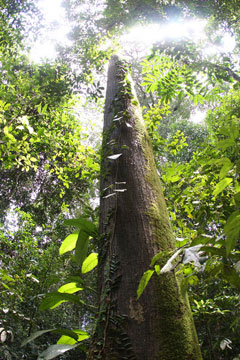 A new report issued by the The Economics of Ecosystems and Biodiversity (TEEB) initiative makes a strong case for valuing the planet’s ecosystem services. The report calls for investments in “ecological infrastructure” to protect wildlands and the services they provide; market-based valuation of ecosystem services; reductions in environmentally harmful subsidies; recognition of the link between […]
A new report issued by the The Economics of Ecosystems and Biodiversity (TEEB) initiative makes a strong case for valuing the planet’s ecosystem services. The report calls for investments in “ecological infrastructure” to protect wildlands and the services they provide; market-based valuation of ecosystem services; reductions in environmentally harmful subsidies; recognition of the link between […]
Important safeguards to protect rainforests lacking in REDD negotiating text
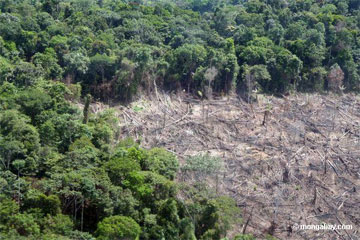 Important safeguards to protect natural forests are still lacking in negotiating text on REDD, a proposed mechanism for mitigating climate change by paying developing countries to keep trees standing, reports an alliance of activist groups. The Ecosystems Climate Alliance (ECA) — a group made up of Global Witness, the Rainforest Action Network, The Wilderness Society, […]
Important safeguards to protect natural forests are still lacking in negotiating text on REDD, a proposed mechanism for mitigating climate change by paying developing countries to keep trees standing, reports an alliance of activist groups. The Ecosystems Climate Alliance (ECA) — a group made up of Global Witness, the Rainforest Action Network, The Wilderness Society, […]
Feeds: news | india | latam | brasil | indonesia
 The state of the REDD+ carbon market in 2012 Logging, conversion to plantations and agriculture, and other drivers of deforestation account for roughly ten percent of anthropogenic greenhouse gas emissions The market for carbon credits generated under projects that reduce emissions from deforestation and forest degradation (REDD) showed signs of stabilizing in 2012 after a […]
The state of the REDD+ carbon market in 2012 Logging, conversion to plantations and agriculture, and other drivers of deforestation account for roughly ten percent of anthropogenic greenhouse gas emissions The market for carbon credits generated under projects that reduce emissions from deforestation and forest degradation (REDD) showed signs of stabilizing in 2012 after a […] Infinite Earth, the developer behind Indonesia’s first approved REDD+ project, has refuted an NGO’s claims that the project has been only partially approved by the Indonesian government. In a statement sent to Mongabay.com, Infinite Earth confirmed that its Rimba Raya project in Central Kalimantan has an ecosystem restoration permit for more than 36,000 hectares of […]
Infinite Earth, the developer behind Indonesia’s first approved REDD+ project, has refuted an NGO’s claims that the project has been only partially approved by the Indonesian government. In a statement sent to Mongabay.com, Infinite Earth confirmed that its Rimba Raya project in Central Kalimantan has an ecosystem restoration permit for more than 36,000 hectares of […] The market for carbon credits generated from projects that reduce deforestation and forest degradation — a climate change mitigation approach known as REDD+ — dipped eight percent in 2012 according to an annual assessment of the global voluntary carbon market. The report, published by Ecosystem Marketplace and Bloomberg New Energy Finance and slated to be […]
The market for carbon credits generated from projects that reduce deforestation and forest degradation — a climate change mitigation approach known as REDD+ — dipped eight percent in 2012 according to an annual assessment of the global voluntary carbon market. The report, published by Ecosystem Marketplace and Bloomberg New Energy Finance and slated to be […] There are two ways to look at Charting New Waters: State of Watershed Payments 2012 – the latest report released by Forest Trends on incentive-based water protection. One is that investments in watershed protection are fast approaching a tipping point – rising 25% from the previous year and with 25% of all recorded investments occurring […]
There are two ways to look at Charting New Waters: State of Watershed Payments 2012 – the latest report released by Forest Trends on incentive-based water protection. One is that investments in watershed protection are fast approaching a tipping point – rising 25% from the previous year and with 25% of all recorded investments occurring […] Mongabay.com is partnering with the Skoll Foundation ahead of the Skoll World Forum on Social Entrepreneurship to bring a series of perspectives that aim to answer the question: how do we feed the world and still address the drivers of deforestation? HOW DO WE FEED THE WORLD AND STILL ADDRESS THE DRIVERS OF DEFORESTATION? Soy, […]
Mongabay.com is partnering with the Skoll Foundation ahead of the Skoll World Forum on Social Entrepreneurship to bring a series of perspectives that aim to answer the question: how do we feed the world and still address the drivers of deforestation? HOW DO WE FEED THE WORLD AND STILL ADDRESS THE DRIVERS OF DEFORESTATION? Soy, […] How a sample payment for ecosystem services project works. Click to enlarge. Unlike cars, hamburgers, and computers, clean drinking water is a requirement for human survival. In a bid to safeguard this essential resource, more and more nations are moving toward protecting ecosystems, such as forests, wetlands, and streams. In fact, according to a new […]
How a sample payment for ecosystem services project works. Click to enlarge. Unlike cars, hamburgers, and computers, clean drinking water is a requirement for human survival. In a bid to safeguard this essential resource, more and more nations are moving toward protecting ecosystems, such as forests, wetlands, and streams. In fact, according to a new […] This commentary was originally published in February, but given that South Sudan has just celebrated independence over the weekend, we thought it apt to re-publish. Oryx and WCS Cessna shadow, Boma National Park. Photo by Paul Elkan and J. Michael Fay. ©2007 National Geographic/ Wildlife Conservation Society. After the people of South Sudan have voted […]
This commentary was originally published in February, but given that South Sudan has just celebrated independence over the weekend, we thought it apt to re-publish. Oryx and WCS Cessna shadow, Boma National Park. Photo by Paul Elkan and J. Michael Fay. ©2007 National Geographic/ Wildlife Conservation Society. After the people of South Sudan have voted […] After the people of South Sudan have voted overwhelmingly for independence, the work of building a nation begins. Set to become the world’s newest country on July 9th of this year, one of many tasks facing the nation’s nascent leaders is the conservation of its stunning wildlife. In 2007, following two decades of brutal civil […]
After the people of South Sudan have voted overwhelmingly for independence, the work of building a nation begins. Set to become the world’s newest country on July 9th of this year, one of many tasks facing the nation’s nascent leaders is the conservation of its stunning wildlife. In 2007, following two decades of brutal civil […] Leaders from around the world meeting in Nagoya, Japan for the Convention on Biological Diversity (CBD) to discuss solutions to stem the current mass extinction crisis may be in need of a little book: The Little Biodiversity Finance Book. While a recent report by The Economics of Ecosystems and Biodiversity (TEEB) found that degradation of […]
Leaders from around the world meeting in Nagoya, Japan for the Convention on Biological Diversity (CBD) to discuss solutions to stem the current mass extinction crisis may be in need of a little book: The Little Biodiversity Finance Book. While a recent report by The Economics of Ecosystems and Biodiversity (TEEB) found that degradation of […] While many factors come into consideration when the fate of forests are being determined, economics often play a key role in land use decisions. When the perceived value of forest land is higher as cattle pasture, cropland, or plantation, then trees fall. But what happens when economic assumptions underlying these decisions are wrong? Forests, including […]
While many factors come into consideration when the fate of forests are being determined, economics often play a key role in land use decisions. When the perceived value of forest land is higher as cattle pasture, cropland, or plantation, then trees fall. But what happens when economic assumptions underlying these decisions are wrong? Forests, including […] $27.9 billion in “fast-start” funding has so far been pledged by industrialized countries to help developing countries mitigate and adapt to climate change, according to a new climate finance tracking tool released by the World Resources Institute (WRI). The tool aims to create transparency around climate change funds to ensure that rich countries follow through […]
$27.9 billion in “fast-start” funding has so far been pledged by industrialized countries to help developing countries mitigate and adapt to climate change, according to a new climate finance tracking tool released by the World Resources Institute (WRI). The tool aims to create transparency around climate change funds to ensure that rich countries follow through […] Norway has agreed to transfer an initial $30 million to Indonesia under its $1 billion REDD+ (reducing emissions from deforestation and forest degradation) partnership with the Southeast Asian country. The fund will go towards Phase I of the partnership, which include “the establishment of an Indonesian REDD+ agency, development of a comprehensive national REDD+ strategy, […]
Norway has agreed to transfer an initial $30 million to Indonesia under its $1 billion REDD+ (reducing emissions from deforestation and forest degradation) partnership with the Southeast Asian country. The fund will go towards Phase I of the partnership, which include “the establishment of an Indonesian REDD+ agency, development of a comprehensive national REDD+ strategy, […] Wawancara dengan Agus Purnomo dan Yani Saloh, Asisten Khusus Presiden Republik Indonesia untuk Perubahan Iklim. Akhir tahun lalu, Indonesia membuat berita di dunia dengan janji yang berani untuk mengurangi penggundulan hutan, yang menghabiskan hampir 28 juta hektar (108 mil persegi) hutan antara tahun 1990 dan 2005 dan merupakan sumber sekitar 80 persen dari emisi gas […]
Wawancara dengan Agus Purnomo dan Yani Saloh, Asisten Khusus Presiden Republik Indonesia untuk Perubahan Iklim. Akhir tahun lalu, Indonesia membuat berita di dunia dengan janji yang berani untuk mengurangi penggundulan hutan, yang menghabiskan hampir 28 juta hektar (108 mil persegi) hutan antara tahun 1990 dan 2005 dan merupakan sumber sekitar 80 persen dari emisi gas […] An interview with Agus Purnomo and Yani Saloh, Special Assistants to the President of the Republic of Indonesia for Climate Change. Late last year Indonesia made global headlines with a bold pledge to reduce deforestation, which claimed nearly 28 million hectares (108,000 square miles) of forest between 1990 and 2005 and is the source of […]
An interview with Agus Purnomo and Yani Saloh, Special Assistants to the President of the Republic of Indonesia for Climate Change. Late last year Indonesia made global headlines with a bold pledge to reduce deforestation, which claimed nearly 28 million hectares (108,000 square miles) of forest between 1990 and 2005 and is the source of […] REDD, responsible logging could help preserve Congo forests, reduce poverty, says report Payments for ecosystem services and sustainable forest management may be key components in maintaining Central Africa’s rainforests as healthy and productive ecosystems, finds a comprehensive assessment of the region’s forests. The review, entitled State of the Forest 2008, was released Thursday at an […]
REDD, responsible logging could help preserve Congo forests, reduce poverty, says report Payments for ecosystem services and sustainable forest management may be key components in maintaining Central Africa’s rainforests as healthy and productive ecosystems, finds a comprehensive assessment of the region’s forests. The review, entitled State of the Forest 2008, was released Thursday at an […] Policy-makers designing a climate change mitigation mechanism that will reduce emissions from deforestation and degradation (REDD) aren’t doing enough to ensure that the scheme protects biodiversity outside carbon-dense ecosystems, argues an editorial published in Current Biology by a prominent group of scientists. The fear is that REDD, which would pay countries for protecting forest carbon […]
Policy-makers designing a climate change mitigation mechanism that will reduce emissions from deforestation and degradation (REDD) aren’t doing enough to ensure that the scheme protects biodiversity outside carbon-dense ecosystems, argues an editorial published in Current Biology by a prominent group of scientists. The fear is that REDD, which would pay countries for protecting forest carbon […] A new report issued by the The Economics of Ecosystems and Biodiversity (TEEB) initiative makes a strong case for valuing the planet’s ecosystem services. The report calls for investments in “ecological infrastructure” to protect wildlands and the services they provide; market-based valuation of ecosystem services; reductions in environmentally harmful subsidies; recognition of the link between […]
A new report issued by the The Economics of Ecosystems and Biodiversity (TEEB) initiative makes a strong case for valuing the planet’s ecosystem services. The report calls for investments in “ecological infrastructure” to protect wildlands and the services they provide; market-based valuation of ecosystem services; reductions in environmentally harmful subsidies; recognition of the link between […] Important safeguards to protect natural forests are still lacking in negotiating text on REDD, a proposed mechanism for mitigating climate change by paying developing countries to keep trees standing, reports an alliance of activist groups. The Ecosystems Climate Alliance (ECA) — a group made up of Global Witness, the Rainforest Action Network, The Wilderness Society, […]
Important safeguards to protect natural forests are still lacking in negotiating text on REDD, a proposed mechanism for mitigating climate change by paying developing countries to keep trees standing, reports an alliance of activist groups. The Ecosystems Climate Alliance (ECA) — a group made up of Global Witness, the Rainforest Action Network, The Wilderness Society, […]